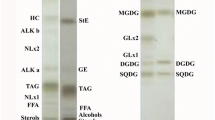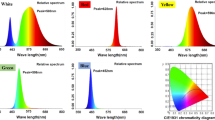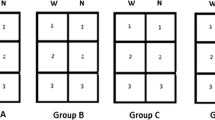Abstract
The marine microalgaePhaeodactylum tricornutum, with a high lipid content constituting 20–60% of its dry weight under controlled growth conditions (1), has recently come into focus as a potentially rich source of dietary marine vegetable oil. In particular, this species has a characteristic high content of eicosapentenoic acid (EPA), which has potential benefits in human nutrition, since it cannot be synthesized in vivo in the human body. Some factors that could alter the biochemical composition ofPhaeodactylum tricornutum in favor of lipid production have been examinated in this study.
Similar content being viewed by others
References
Regan, D. L. (1988), inMicro-algal Biotechnology, Borowitzka, M. A. and Borowitzka, L. J., eds., Cambridge University Press, pp. 135–150.
Orcutt and Paterson (1975),
Thomas, W. H., Seibert, D. L. R., Alden, M., Neori, A., and Eldridge, (1984),Biomass 5, 181–209.
Dorsey, T. E., McDonald, P., and Roels, O. A., (1978),J. Phycol. 14(2), pp. 167–171.
Kochert, G. (1978), inHandbook of Phycological Methods, Physiological and Biomedical Methods, Hellebust, J. A. and Craigie, J. S., eds., Cambridge University Press, pp. 95–97.
Borowitzka, M. A. (1988), inMicro-Algal Biotechnology, Borowitzka, M. A. and Borowitzka, L. J., eds., Cambridge University Press, pp. 257–287.
D'Elia, C. F., Guillard, R. R. L., and Nelson, D. M., (1979),Marine Biology 50, 305–312.
Dorsey, T. E., Mcdonald, P. W., and Roels, O. A., (1977),Analytical Biochemistry 78, 156–164.
Harwood, J. L., Pettitt, T. P., and Jones, A. L., (1988), inBiochemistry of the Algae and Cyanobacteria, Rogers, L. J. and Gallon, J. R., eds., Clarendon Press, Oxford, pp. 49–67.
Kenrick, J. R., Deane, E. M., and Bishop, D. G., (1984),Phycologia 23(1), 73–76.
Kochert, G. (1978), pp. 189–195.
Nelson, D. M., D'Elia, C. F., and Guillard, R. P. L., (1979),Marine Biology 50, 313–318.
Terry, K. L., Hirata, J., & Laws, E. A., (1983),J. Exp. Mar. Biol. Ecol. 68, 209–227.
Author information
Authors and Affiliations
Rights and permissions
About this article
Cite this article
KaiXian, Q., Borowitzka, M.A. Light and nitrogen deficiency effects on the growth and composition ofPhaeodactylum tricornutum . Appl Biochem Biotechnol 38, 93–103 (1993). https://doi.org/10.1007/BF02916415
Received:
Accepted:
Issue Date:
DOI: https://doi.org/10.1007/BF02916415




